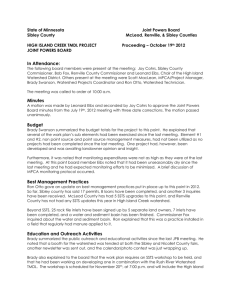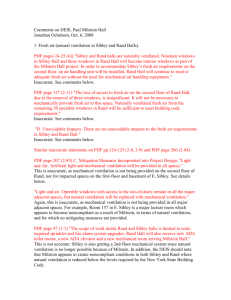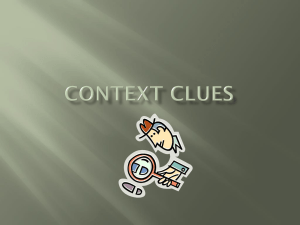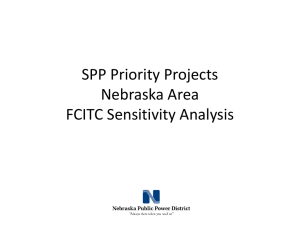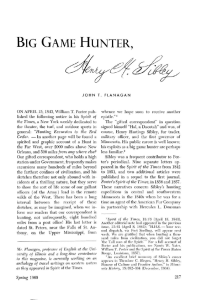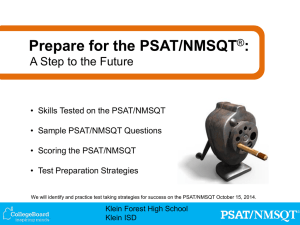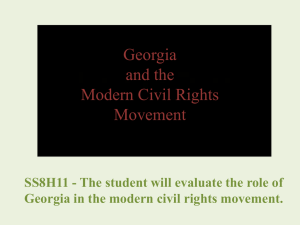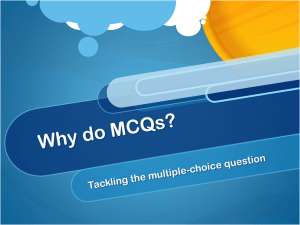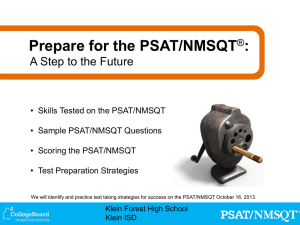Using Context Clues to Help Define Words and Phrases
advertisement
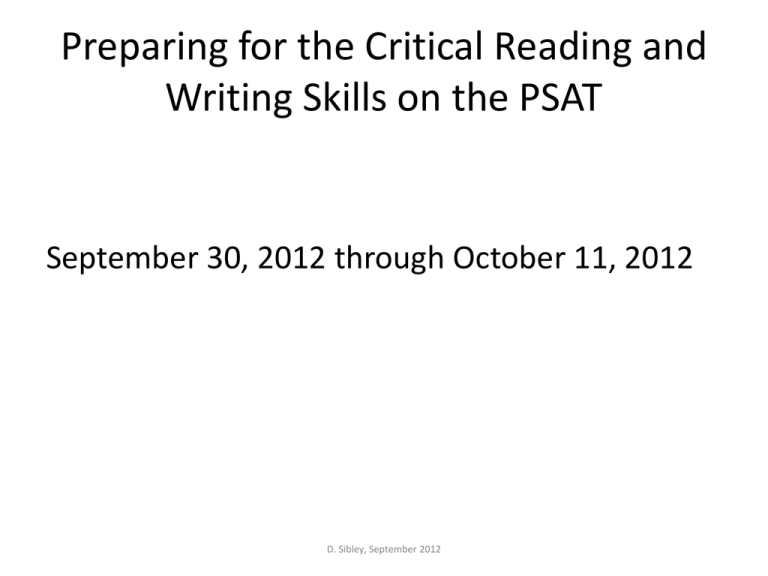
Preparing for the Critical Reading and Writing Skills on the PSAT September 30, 2012 through October 11, 2012 D. Sibley, September 2012 PSAT Test Format taken from Barron’s PSAT/ NMSQT, 2012 • The PSAT/NMSQT is preparation for the SAT, and is generally given in October. It differs from the SAT in that it is shorter (2hours and 10 mins.). • Sec. 1- Critical Reading 25 mins. 24 questions • 8 sentence completion • 4 short-reading comprehension • 12 long-passage reading comprehension • 1 min break • Sec. 2-Math 25 mins. 20 questions • 20 multiple choice • 20 questions • 1 min. break D. Sibley, September 2012 Passive vs. Active Reading Passive • Leisure reading • Skimming for ideas Active • • • • Reading for content Engaging with the text Using prior knowledge Taking Notes D. Sibley, September 2012 Active Reading • • • • Preview the reading material Estimate the length and level of difficulty Clarify your purpose for reading Activate prior knowledge Rhetorical Triangle and Reader Response Theory D. Sibley, September 2012 PSAT/NMSQT Test Format • • • • • • • • • • • • • Sec. 3- Critical Reading 25 mins. 24 questions 5 sentence completions 4 short-paragraph reading comprehension 15 long-passage reading comprehension 5 min. break Sec. 4- Math 25 mins. 18 questions 8 multiple-choice 10 student-produced response (grid-in) 1 Min. break Section 5- Writing Skills 30 mins. 39 questions 20 improving sentences 14 identifying sentence errors 5 improving paragraphs D. Sibley, September 2012 Using Context Clues to Help Define Words and Phrases and Build Your Vocabulary Let’s look at the Types of Context Clues D. Sibley, September 2012 Definition Context Clues • You will see questions on the PSAT that may ask you for the meaning of a word and the passage may contain a definition of the word you are being asked to define. For example: • “A distinctive perspective is central to the discipline of sociology, which is defined as the scientific study of human social activity.” • “Words take on meaning from their context, that is, they are used in conjunction with other words in the sentence and surrounding sentences.” • “Like terms are terms that have the same variables with the same exponents.” D. Sibley, September 2012 An Example Context Clue • You may encounter a question that asks for the meaning of a word, and several examples of the word are included in the passage to help lead you to a definition: • “Macionis helps us understand the term subculture. Teenagers, Polish-Americans, the homeless, and “southerners” are all examples of subcultures.” D. Sibley, September 2012 An Explanation Context Clue • Some passages may include an explanation of the term to help you define the term. • “The psychologist set up the experiment to test the rat’s adaptability; he wished to see how well the rat adjusted to the changing conditions it had to face.” D. Sibley, September 2012 An Opposite Term Context • You may find the opposite meaning of a term included in the passage that may help you define the term: • “ In general, people emigrate to from countries where they have limited prospects for earning a living, and they migrate to countries where they believe that economic opportunity awaits them.” • Most birds of prey hunt by day; owls; however, are nocturnal.” D. Sibley, September 2012 A Punctuation Context Clue • Sometimes, writers use punctuation marks (dashes, colons, parentheses, or commas) in a passage to lead readers to the definition of a term. • “A composer often provides a marking for tempo, or overall speed, to help convey the character of a composition.” • “In a sense, there is no single cause for war, but a myriad.” D. Sibley, September 2012 Using Parts of the Word to Help Define It • We add prefixes and suffixes to root words to change word meanings, or make new words. • When you are taking the PSAT, you can look at the root word to help you determine the meaning of a word, if the passage does not include context clues For example, lets look at the word perihelion • Peri from the Greek meaning near and helios from the Greek meaning the sun, so the perihelion is the point in the orbit of a planet, asteroid or comet where it is nearest to the sun. (taken from Wikipedia) ***Obtain a list of common root words, suffixes, and prefixes. D. Sibley, September 2012 Using the Dictionary to Help Build Vocabulary • You may be required to define a term that does not include context clues in the passage and cannot be defined by looking at its root word, prefix, nor suffix. • It is important to get a list of words commonly used on the PSAT/SAT (high-frequency words) and learn their definitions. You can go to www.collegeboard.com to get words and their definitions daily, or you can obtain a list from the website. • I would suggest putting the words and their definitions on flashcards the old-fashioned way, or create electronic flashcards, and make a game of it!!! D. Sibley, September 2012


